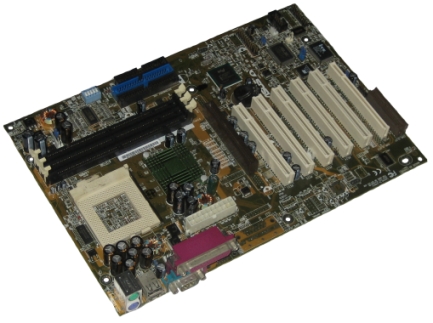Internal Computer Hardware
Introduction
Computer Hardware is the physical part of a computer, as distinguished from the computer software that executes or runs on the hardware. The hardware of a computer is infrequently changed, while software and data are modified frequently. The term soft refers to readily created, modified, or erased. These are unlike the physical components within the computer which are hard.
When you think of the term computer hardware you probably think of the guts inside your personal computer at home or the one in your classroom. However, computer hardware does not specifically refer to personal computers. Instead, it is all types of computer systems. Computer hardware is in embedded systems in automobiles, microwave ovens, CD players, DVD players, and many more devices. In 2003, only 0.2% of all microprocessors sold were for personal computers. How many other things in your house or your classroom use computer hardware?

Motherboard
The motherboard is the body or mainframe of the computer, through which all other components interface. It is the central circuit board making up a complex electronic system. A motherboard provides the electrical connections by which the other components of the system communicate. The mother board includes many components such as: central processing unit (CPU), random access memory (RAM), firmware, and internal and external buses.

Central Processing Unit
The Central Processing Unit (CPU; sometimes just called processor) is a machine that can execute computer programs. It is sometimes referred to as the brain of the computer.

There are four steps that nearly all CPUs use in their operation: fetch, decode, execute, and writeback. The first step, fetch, involves retrieving an instruction from program memory. In the decode step, the instruction is broken up into parts that have significance to other portions of the CPU. During the execute step various portions of the CPU, such as the arithmetic logic unit (ALU) and the floating point unit (FPU) are connected so they can perform the desired operation. The final step, writeback, simply writes back the results of the execute step to some form of memory.
Random Access Memory
Random access memory (RAM) is fast-access memory that is cleared when the computer is power-down. RAM attaches directly to the motherboard, and is used to store programs that are currently running. RAM is a set of integrated circuits that allow the stored data to be accessed in any order (why it is called random). There are many different types of RAM. Distinctions between these different types include: writable vs. read-only, static vs. dynamic, volatile vs. non-volatile, etc.

Firmware
Firmware is loaded from the Read only memory (ROM) run from the Basic Input-Output System (BIOS). It is a computer program that is embedded in a hardware device, for example a microcontroller. As it name suggests, firmware is somewhere between hardware and software. Like software, it is a computer program which is executed by a microprocessor or a microcontroller. But it is also tightly linked to a piece of hardware, and has little meaning outside of it. Most devices attached to modern systems are special-purpose computers in their own right, running their own software. Some of these devices store that software (“firmware”) in a ROM within the device itself
Power Supply
The power supply as its name might suggest is the device that supplies power to all the components in the computer. Its case holds a transformer, voltage control, and (usually) a cooling fan. The power supply converts about 100-120 volts of AC power to low-voltage DC power for the internal components to use. The most common computer power supplies are built to conform with the ATX form factor. This enables different power supplies to be interchangable with different components inside the computer. ATX power supplies also are designed to turn on and off using a signal from the motherboard, and provide support for modern functions such as standby mode.
Removable Media Devices
If your putting something in your computer and taking it out is most likely a form of removable media. There are many different removable media devices. The most popular are probably CD and DVD drives which almost every computer these days has at least one of. There are some new disc drives such as Blu-ray which can hold a much larger amount of information then normal CDs or DVDs. One type of removable media which is becoming less popular is floppy disk.
CD
CDs are the most common type of removable media. They are inexpensive but also have short life-span. There are a few different kinds of CDs. CD-ROM which stands for Compact Disc read-only memory are popularly used to distribute computer software although any type of data can be stored on them. CD-R is another variation which can only be written to once but can be read many times. CD-RW (rewritable) can be written to more than once as well as read more than once. Some other types of CDs which are not as popular include Super Audio CD (SACD), Video Compact Discs (VCD), Super Video Compact Discs (SVCD), PhotoCD, PictureCD, CD-i, and Enhanced CD.
